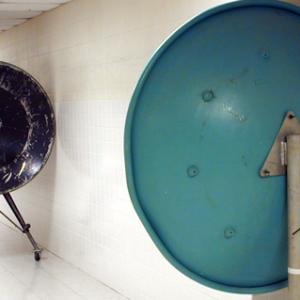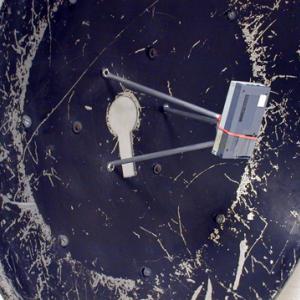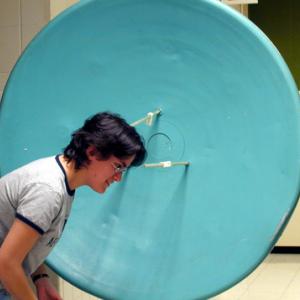College of Liberal Arts & Sciences
3B35.39 - Curved Reflectors - Whispering Gallery
Attach the tape player to the focal point of one of the reflectors. Align the reflectors so that they are parallel and some long distance apart (greater than 25 ft.). When the reflectors are aligned properly the tape player can be turned down to a volume that cannot be heard when standing near the other reflector unless you hold your ear to the focal point of that reflector.
- Thomas B. Greenslade, Jr., "Whispering Galleries", TPT, Vol. 18, # 1, Jan 1980, p. 52.
- Thomas B. Greenslade, Jr., "19th Century Textbook Illustrations IV", TPT, Vol. 13, # 9, Dec. 1975, p. 522.
- Robert H. Johns, "Parabolic Reflectors for Sound", TPT, Vol. 11, # 9, Dec. 1973, p. 567.
- Jearl Walker, "Some Whispering Galleries Are Simply Sound Reflectors, But Others Are More Mysterious", The Amateur Scientist, Oct. 1978.
- George M. Hopkins, "Reflection and Concentration of Sound", Experimental Science, p. 158.
- Pat Murphy, Ellen Macaulay, and the staff of the Exploratorium, "Talk to a Wok", Exploratopia, p. 350.
- Jearl Walker, "3.63, Whispering Gallery in St. Paul's Cathedral", The Flying Circus of Physics Ed. 2, p. 171.
- Jearl Walker, "3.62, Whispering Galleries in Various Enclosures", The Flying Circus of Physics Ed. 2, p. 171.
- Ron Hipschman, "Focused Sound", Exploratorium Cookbook II, p. 115.1.
Disclaimer: These demonstrations are provided only for illustrative use by persons affiliated with The University of Iowa and only under the direction of a trained instructor or physicist. The University of Iowa is not responsible for demonstrations performed by those using their own equipment or who choose to use this reference material for their own purpose. The demonstrations included here are within the public domain and can be found in materials contained in libraries, bookstores, and through electronic sources. Performing all or any portion of any of these demonstrations, with or without revisions not depicted here entails inherent risks. These risks include, without limitation, bodily injury (and possibly death), including risks to health that may be temporary or permanent and that may exacerbate a pre-existing medical condition; and property loss or damage. Anyone performing any part of these demonstrations, even with revisions, knowingly and voluntarily assumes all risks associated with them.


